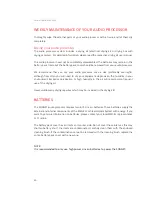
General precautions and warnings
46
The following section applies to all other types of implants (CONCERTO, SONATAti
100
,
PULSARci
100
, C40+, C40)
MRI CAUTION
MRI is possible in patients with cochlear or auditory brainstem implants only with specifi ed
models of MRI machines.
Evidence has been provided for these implants to pose no known hazard in magnetic fi eld
strengths of 0.2 T, 1.0 T and 1.5 T (without surgical removal of the internal magnet) when the
following safety recommendations and guidelines are adhered to. The physician/MRI operator
should always be informed that a patient is a cochlear implant or an auditory brainstem
implant user and that special safety recommendations and guidelines have to be followed.
Safety recommendations and guidelines for MRI scanning:
• MRI scanner with static magnetic field strength of 0.2 T, 1.0 T or 1.5 T only. No other field
strengths are allowed. (When using other field strengths, injury to the patient and/or
damage to the implant are possible.)
• MRI scan not earlier than 6 months post implantation. (Performing an MRI at an earlier
stage may result in implant displacement and/or damage to the implant).
• A minimum thickness of the bone underneath the implant magnet of 0.4 mm is required
in order to withstand forces of 5 N (equals a gravitational force of about 0.5 kg) or up
to 9 N for the C40 cochlear implant. (In an MRI scanner torque forces act on the implant
magnet, exerting rotational pressure: the device will try to turn to line up with force
lines. The resulting forces on the edges of the implant are counterbalanced by the cranial
bone and the skin flap. Bone underneath the implant magnet should be thick enough to
withstand these exerting forces.)
• Patients with mechanically damaged implants must not undergo MRI. (Ignoring this
guideline could result in injury to the patient.)
Safety Guidelines:
• Before patients enter any MRI room all external components of the implant system
(audio processor and accessories) must be removed. For field strengths of 1.0 T or 1.5 T
a supportive head bandage must be placed over the implant. A supportive head bandage
may be an elastic bandage wrapped tightly around the head at least three times (refer
to Fig. A). The bandage shall fit tightly but should not cause pain.
• Head orientation: In case of 1.0 T and 1.5 T systems, the longitudinal axis of the head
must be parallel to the main magnetic field of the scanner. For example this is the case
when the patient is in a supine position with the head kept straight. (The patient should
not turn or bend his/her head to the side; otherwise partial demagnetization of the
implant magnet is possible.) In case of 0.2 T scanners, no specific head orientation is
required.
















































